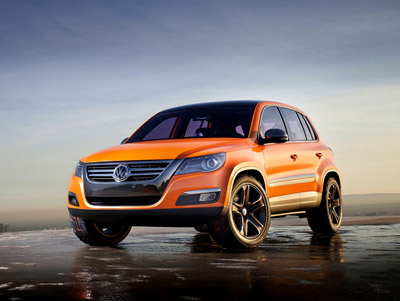Volkswagen
The engineers at Volkswagen sure love tinkering with the Golf. First came the famed R32 - an all-wheel drive hatch that many feel is the ultimate in hot hatches. A VW with a 3.2-liter V6 is all well and good, but ze German engineers still felt as if the car could use more power. So the next "R"-tuned Golf - which hasn't yet made it to production - will come packing an even bigger Passat-sourced 3.6-liter V6. Will this R36 be the pinnacle of fast Volkswagen hatchbacks? No. Not by a long shot.Volkswagen engineers feel that a small vehicle like the Golf needs an engine with more than six cylinders; VW's small city car needs an engine with twice that amount. Oh, and if the engine ditched the traditional "V" shape for a more VW-like "W", that would be even better. Yes, we know that this seems like an unlikely scenario, but we can't think of any other reason as to why Volkswagen felt the need to build a W12-powered RWD 2-door hatch.
The official name of the car you see here is "Golf GTI W12-650". If you've been paying attention so far, you can likely guess what the "Golf", "GTI" and "W12" in the car's name mean. The extra smart readers out there will also be able to guess that the "650" in the name refers to the car's (metric) horsepower output. It doesn't take a rocket scientist to figure out that a 12-cylinder motor is much larger than the stock GTI's four-banger. You can also easily guess that it would be difficult to shoehorn eight extra cylinders into the VeeDub's already tight engine bay, so the VW engineers didn't even try - they just ripped out the back seats and mounted the engine right behind the driver and front passenger.
Getting fresh air to a cabin-mounted engine is difficult enough as it is - getting enough air to feed and cool a massive 12-cylinder engine is even tougher. VeeDub wanted the GTI W12-650 to keep its classic GTI shape, meaning that the engineers weren't allowed to slap a DTM car's-worth of ducts on to the thing. Yeah, this concept has a massively wide body kit with a couple of noticeable air ducts, but the main ducts that feed the engine are stealthily hidden away in the C-pillar. Go back and take a closer look at the rear quarter windows - they open inward creating cold air ducts for the W12.
The massively blistered fenders (4.72 inches wider than stock) and hunkered-down stance (3.14 inches lower than stock) may look wild, but VW went to great lengths to keep any and all unsightly wings off of this car. VW is saying that a lot of time went into engineering the look and function of the GTI W12-650, and according to VW, this entire car is one giant diffuser. The carbon fiber roof was designed to work with the undercarriage of the GTI, meaning that the body itself acts as a wing and keeps this high-strung hatch glued to the ground.
The GTI W12-650's interior was "designed for racing". Seating surfaces are covered in grippy Alcantara; important switches - such as the "ESP off" switch - have flip up covers to prevent any accidental switch activations; and all door trim has been stripped for weight savings. We don't know what it is about Germans and their odd ideas of what it means to save weight for racing; like other German cars with all "unnecessary" weight removed, the GTI W12-650 has a full DVD navigation system. We guess that when racing in a 12-cylinder VW, one needs instant directions to the nearest schnitzel joint.
Added weight of the navigation system aside, the GTI W12-650 can really move. Volkswagen claims that this little hatch can hit 62 miles per hour in 3.7 seconds. This ultimate GTI is also said to be able to hit speeds of 325 km/h (201 mph) with little to no effort. Perhaps ditching the door panels really does make a difference.
Like every other incredibly cool car we feature on this site, the Volkswagen Golf GTI W12-650 is a concept only. You'll never be able to buy one of these from your local Volkswagen dealer, but something tells us that if you could, your money would be better spent on something cheaper like a Lamborghini Murcielago. Will this Volkswagen concept start a trend of Touareg/Phaeton-powered Mk5 Golfs? Only time will tell. In the meantime, check out our Media Page for more pictures of the hottest of all hot hatches.

Volkswagen tried to compete with luxury automakers when it debuted the ill-received Phaeton a few years ago. This year, the company is at it again with the Passat CC. Volkswagen is calling the four-door a coupe, and it has a sloping roofline much like that of the Mercedes CLS. The CC is about 1.5 inches longer than a regular Passat and just slightly wider.
We're not sure where VW is going with the Passat CC. The company says the driving dynamics will offer a more sporting ride, but there isn't much talk in the voluminous press kit about much that's been done to the car to make it perform better than a standard Passat. Engine choices are the same as the regular sedan, with the six-cylinder gaining roughly 15 horsepower. The minimally wider stance won't help handling that dramatically, nor will the more aerodynamic shape.
There are a lot more technological gadgets added to the CC, though, including an adjustable suspension system called Dynamic Drive Control, which will probably be an option in the U.S. We usually find systems like this neither dynamic nor interesting in real-world driving. There will also be a park assist system — as part of an option package — that will steer the car into a parking spot using cameras, sensors and software much like the new Lexus LS. Drivers will control the braking and acceleration during the maneuver, but the car will turn the steering wheel to fit into a tough spot. A Lane Assist program sounds similar to Infiniti's setup, correcting the Passat CC if it strays into a lane it shouldn't. All-wheel drive will also be available.
Pricing hasn't been finalized for the CC, but we know it will start in the mid- to high-$20,000 range and could easily top $40,000 when well-equipped with features like park assist. That's still roughly $20,000 less than the Lexus LS460 that parks itself.




















0 comments:
Post a Comment